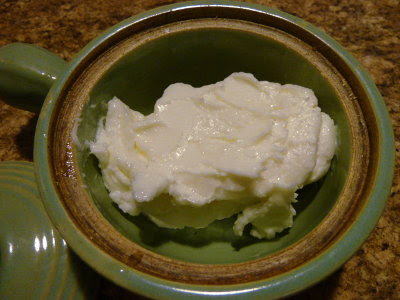

| Visitors Now: | |
| Total Visits: | |
| Total Stories: |

| Story Views | |
| Now: | |
| Last Hour: | |
| Last 24 Hours: | |
| Total: | |
Goats’ Milk Butter For Two
Remember this photo from “Ziggy Milk, Ziggy Butter, Ziggy Mozz”?
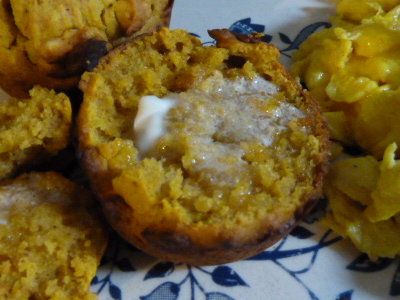 |
| Goat butter on freshly baked pumpkin muffin |
Farmer Barb (Life Rock Farm) and Brenda (A Separate Path), were interested in how I make my butter, so in this post I’ll show you my method. I’ll also share everything I’ve learned about the process, both through research and experience.
First, a little about raw goats’ milk.
You may have read that cream cannot be obtained from goats milk because it is naturally homogenized. Is that true? In my experience, no, this is not true. Cream does indeed rise on goats’ milk and can be skimmed. Why then, do folks (even goat owners) sometimes say it’s naturally homogenized? There may be several reasons.
The fat globules in goats’ milk are smaller than those in cows’ milk. This is one of the reasons why goats’ milk is more easily digested than cows’ milk. (This has nothing to do with lactose intolerance, which is the inability to digest lactose, a milk sugar). Being smaller, the fat globules are slower to rise, but also, those in goats’ milk apparently do not cling together as readily as the fat globules in cows milk. I find it has to sit in the fridge for several days to really get enough to skim. Those who use their goats milk within 24 hours, likely won’t see a cream line, which may contribute to the idea of natural homogenization.
Regarding freshness, depending on cleanliness and how quickly it’s cooled, raw milk will stay fresh for longer than you’d think, like a couple of weeks. This brings up another point about raw milk, it doesn’t actually spoil, it sours. When pasteurized milk goes bad, it putrefies. Anyone who has sniffed a jug of old store bought milk knows what I mean. Raw milk on the other hand, will smell sour.
Many an old time recipe calls for sour milk and saleratus (baking soda) to leaven baked goods. The reaction of an acid (sour milk), combined with a base (baking soda), creates carbon dioxide bubbles, which cause the batter to rise. On the one occasion I had milk that soured, I saved it for baking. Soured, it keeps for months and makes absolutely heavenly chocolate cake. It can also be fed to chickens and pigs.
Another reason for the idea of natural homogenization, may be the breed of the goat. Some breeds produce more butterfat than others. Individuals may vary, but in general, Nigerian Dwarfs and Kinders produce the highest amounts of butterfat, 6 – 7% plus. Nubians come in next, with 4 – 5%, followed by LaManchas with 4+%. Most other breeds produce less than 4%. Butterfat is what gives richness to the milk, plus rises to the top as cream. Lower butterfat will mean less, and perhaps negligible cream.
Making Butter
I have small goats, small amounts, and small needs. At this time in the season, I’m getting about a quart of milk per day. This is strained into wide mouth canning jars. I find the wider mouthed jars easier to skim the cream. After the milk sits in the fridge for about 3 to 5 days, I use a slotted spoon to skim off the cream. It is thick and rich.
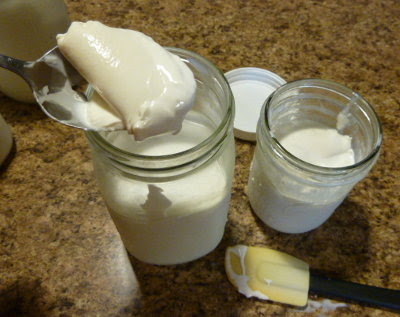 |
| Hand skimming cream from raw goats milk. We get plenty of cream for whipped cream and butter, for just the two of us. |
I skim all my milk except what I’m saving to make hard cheese. Last year I learned that skim milk cheese in nowhere near as tasty as whole milk cheese. Mozzarella, on the other hand, is fine with my skimmed milk. Hand skimming doesn’t get every drop, but that’s okay. I get enough for what I need, and it leaves some for richer milk, yogurt, and mozzarella. If I wanted all the cream or had more milk to deal with, I’d likely consider a cream separator. These can be purchased in either electric or manual models, but cost hundreds of dollars. That doesn’t make sense for us at this time.
I put the cream into wide mouth pint jars and store in the freezer.
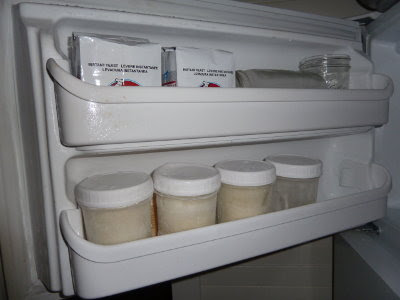 |
| Pint jars of cream are stored in the freezer |
I keep adding until the jar is full. When I need to make butter, I take one of the jars from the freezer and let it thaw on the countertop. It needs to be about room temperature to make butter most efficiently. Colder, and it takes longer. We like ours from sweet cream, but some people prefer it cultured. More info on that, here.
To churn, I pour the cream into a quart jar with a tight lid. This gives plenty of room for the cream to slosh around. I just shake the jar by hand. With only a pint of cream, it doesn’t take too long, the batch you see below took 6 minutes.
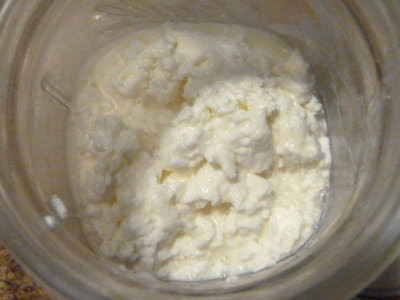 |
| Butter in a wide mouth quart canning jar. |
At one time I had a gallon size butter churn. Because I hadn’t used it for years, it was given away during one of my many moves < sigh>. It would actually be too big for the amounts I make now, but I still wish I had it anyway. An alternative would be using a mixer, here, or in a blender, here.
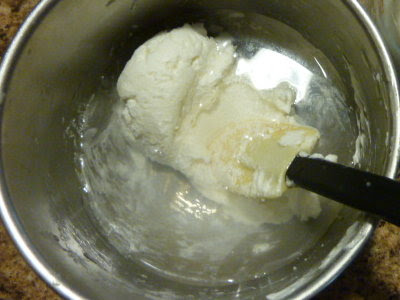 |
| Washing the butter and working out the buttermilk |
The next step is washing the butter. Because the cream was room temperature, the butter is soft and I find working it in cold water easiest. During summer months our city tap water is not very cold, so I put a pitcher of water in the fridge to use for this step. By pressing or kneading the butter with a scraper, all the buttermilk is worked out and it will keep for quite awhile. How long I couldn’t say for sure because we use ours up in several weeks. Butter can be frozen, also clarified (ghee) to increase shelf life. How to here. I also saw a butter keeper in my Lehman’s catalog that has me curious.
Once is rinsed and drained, I work in a little salt, and pack it into an small lidded crock given to me by my grandmother.
Goat butter is white, because goat milk contains no beta-carotene. It is absolutely delicious though, so I never give the color a thought.
There are quite a few links in the post, but here are a few more if you’re interesting:
- Butterfat Goat Facts at Easy Living the Hard Way
- The Chemistry of Cream, Healthnews-NZ
- Dairy Goat Milk Composition, GoatWorld
- Vitamins in milk: goat compared to cow, Everything Goat Milk
Click on the icon or link for more, or to join in.
2012-11-27 10:26:03
Source: http://www.5acresandadream.com/2012/09/goats-milk-butter-for-two.html
Source:



